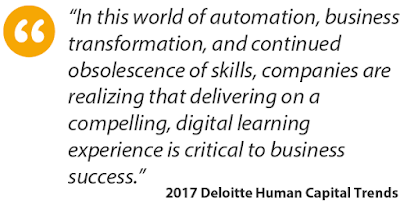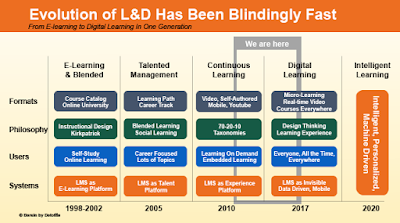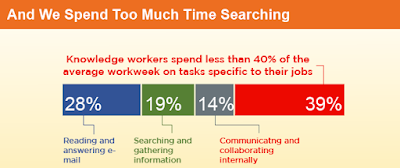Why is there a need to access knowledge anytime? Also, why is there an increasing need for us to search for good training opportunities and push learning? Are you ready to take advantage of this trend?
There’s a new corporate learning landscape called “digital learning,” where the emergence of digital content and tools are reinventing professional development for digital access. It “enables businesses and employees to learn like never before.”How does this impact our interest in implementing Microlearning?
How does this impact our interest in implementing Microlearning?
Deloitte released this study. The insights tell us that we are now in a new environment that propels a different type of learning.
“This topic is now the #2 topic on the minds of CEO and HR leaders. The 2017 Deloitte Human Capital Trends research discovered that 83% of companies rate this issue important and 54% rate it urgent, up 11% from last year.”
Digital Learning Disruption and Microlearning Opportunities

Digital learning isn’t a type of learning. Neither is it mobile learning or learning on your phone. It’s a way of learning that brings learning to where employees are.
In my view, Digital Learning parallels or seamlessly encourages the application of the Microlearning approach to learning in the workflow. It confirms our earlier thinking about how we are moving into learning on demand today – how everyone could learn all the time and anywhere.
Bringing Learning Where Employees Are: Microlearning Tips
Trim down huge learning content to bite-sized 25-minute (or less) learning
The study further suggests that our need to constantly search for information has increased:
“We spend an inordinate amount of time looking for information at work, and we are constantly bombarded by distractions, messages, and emails.”
“And all this effort is not necessarily making us more productive. In addition to spending as much as 25% of our time doing email, we’re now taking almost a week less vacation than we did in the 1990s (Project: PTO) and we spend an inordinate amount of time looking for information. Our research shows that in a given week, employees take less than 25 minutes of time to actually slow down and learn.” — 25 minutes is more than enough time to consume bite-sized learning content
Ideas to ponder
The study results confirm two key Microlearning tips we shared with you earlier.
| 1 | Need to search to find quick answers is a must-skill in Microlearning Learners and workers forage and sniff content. Due to the constant flow of content and the need to find solutions to problems on the job, we learn to find patterns and review the value of content a lot faster. The study of Project: PTO suggests that the increasing need to search is a distraction and therefore makes it difficult for learners to spend more time on digesting content. From a learning consumption point of view, the distractions present a challenge, since our expectation is that learners need to focus and study. This argument assumes that the act of learning is separate from the the workflow. In the workflow, learners search for an answer and use a small amount of content that provides an answer. Hence, they focus on application. Application is a different behavior from learning.  |
|||
| 2 | “River of News” is the new environment we need to help learners and workers The behavior of foraging and sniffing coupled with the anytime, anywhere and anyhow learning become the new normal. Solutions to problems and issues at work don’t reside in learning content. In fact the content we produce in most formal learning, e.g. classroom, elearning, FAQs are the least sources for quick solutions while at work. Most answers come from the company portal, company databases, industry blogs, supplier information, quick messaging and conversations with peers on the job. These methods are closer to the worker while on the job compared to most learning programs. Our focus in Microlearning is not about ‘producing content” but rather managing the “River of News”, with all types of sources for answers, managing them in order to help the workers find quick answers. Our content is NO LONGER the source, has never been the source for answers to problems on the job.  |
Conclusion
There are dominant trends that shift the very foundation of how we help learners work better to produce results. The shifts are opportunities for us to identify very specific tactical actions so we are working with inertia. In our case, we espouse Microlearning as quick ways to find answers for work issues. We look at the trends and shifts that accelerate helping workers fix, solve and improve issues at work.
Related Tips
How Micro-Learning Boosts “At the Moment Performance”
5 Success Strategies in Micro-Learning Implementation
Why Does Micro-Learning Mean Better Learning?
Micro-Learning Leads to Rapid Skill Acquisition
Why Simple Rules Produce Instant Learning and Application
References
The Disruption of Digital Learning: Ten Things We Have Learned
2017 Deloitte Human Capital Trends
Project: PTO
Tip #134 – Microlearning Leads to Rapid Skill Acquisition
Tip #135 – Learning by SNIFFING: Are Learners Really Distracted or Are They Learning Differently
Tip #114 – How Microlearning Boosts “At the Moment Performance”
Previous Tips
The Disruption of Digital Learning: Ten Things We Have Learned
2017 Deloitte Human Capital Trends
Project: PTO
Tip #134 – Microlearning Leads to Rapid Skill Acquisition
Tip #135 – Learning by SNIFFING: Are Learners Really Distracted or Are They Learning Differently
Tip #114 – How Microlearning Boosts “At the Moment Performance”
Ray Jimenez, PhD
Vignettes Learning
“Helping Learners Learn Their Way”



